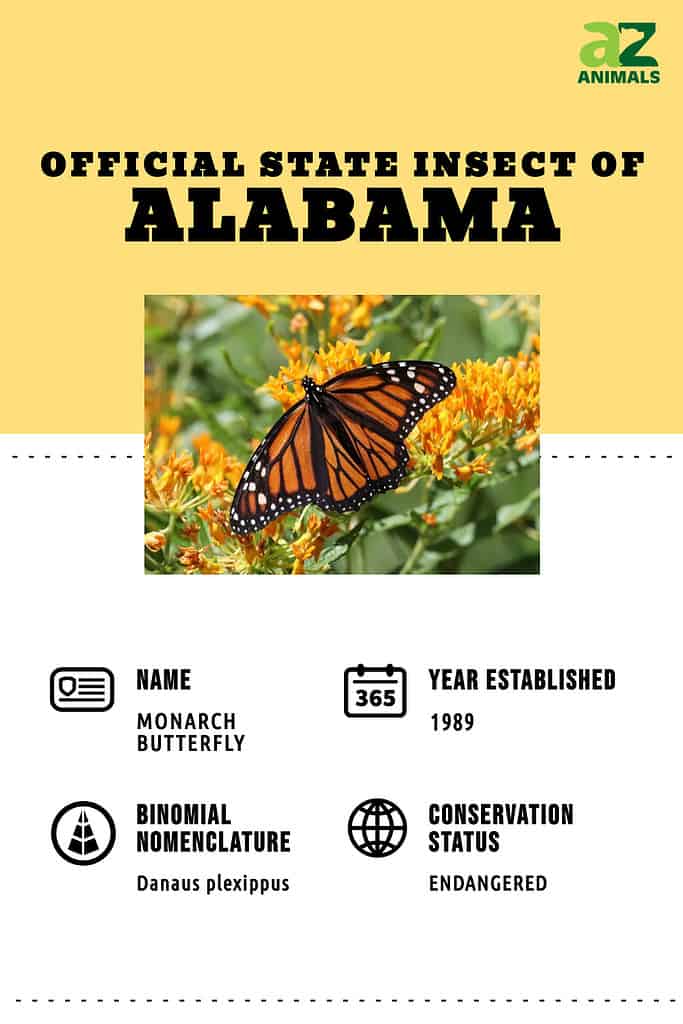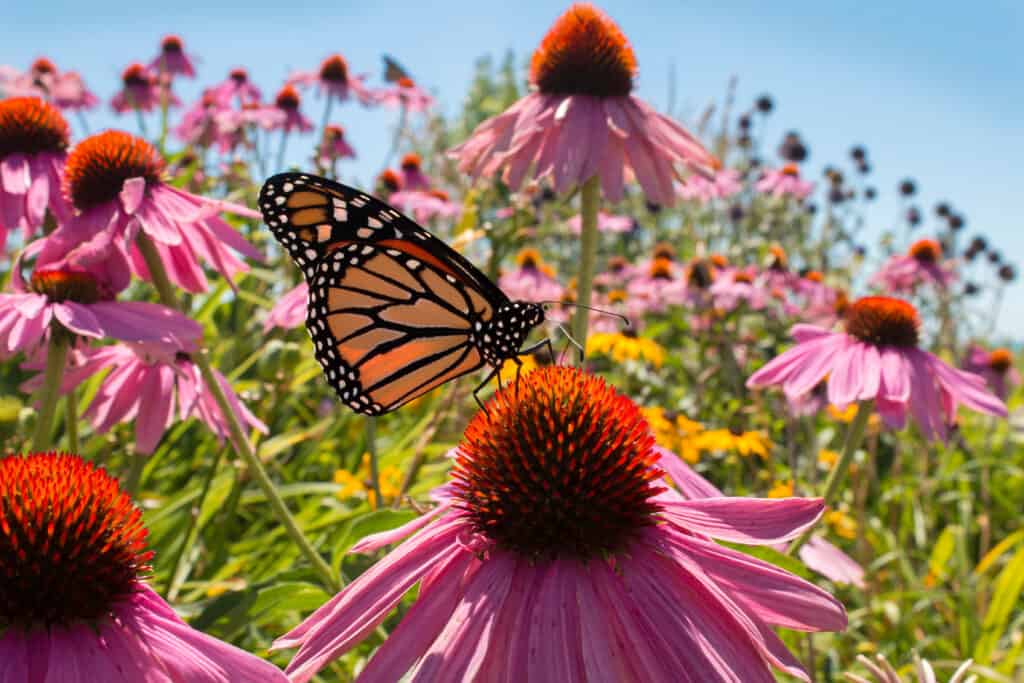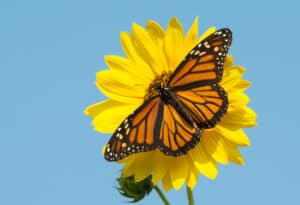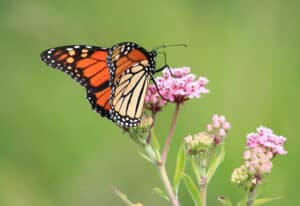The most renowned and famous butterflies in the U.S. are monarchs. They are common inhabitants of Alabama, and you can find them just about everywhere. However, most Alabamans only see them in the spring and autumn months when they travel through the state on their trip to and from their wintering grounds due to their migratory routes.
The official Alabama state insect is the Monarch butterfly. The Alabama legislature designated the local butterfly as the state insect in 1989. Authorities from Selma, which had dubbed the city the Butterfly Capital of Alabama in 1982, demanded the action.
Numerous butterfly monuments created by different artists were placed all over Selma to commemorate this accomplishment, and more recently, a vibrant butterfly mural was added. Learn more about the Alabama state insect below.
Appearance

The brilliant coloring of monarch butterflies serves as a warning to potential predators that the species is poisonous.
©Sari ONeal/Shutterstock.com
The wingspan of an adult monarch butterfly is roughly four inches. Their deep orange upper wings have a broad, black border with white dots interspersed with black veins.
To blend in with tree bark, the underside of their wings has a bland orange tint. Males have a black patch on each of their rear wings, and they are marginally larger than females. The body of a monarch caterpillar is covered in black, white, and yellow bands, as well as two long black filaments near the head and two shorter filaments near the back.
Due to the buildup of deadly chemicals created by milkweed plants in their bodies, the brilliant coloring of adults serves as a warning to potential predators that the species is poisonous. Nevertheless, other invertebrates feed on caterpillars, such as wasps and ants.

Monarch Butterfly Habitat
The habitat for monarch butterflies must have milkweed and blooming plants, whether it be a meadow, highway area, open space, wet region, or an urban park. During migration and reproduction, adult monarchs eat nectar from various flowers. However, they can only lay an egg on milkweed plants.
Monarchs that overwinter require a habitat with a particular microclimate for shelter from the weather and moderate temperatures to prevent freezing. Across populations, these requirements differ.
Most monarchs from eastern North America spend the winter in oyamel fir tree nesting grounds in central Mexican mountains around 12,000 feet above sea level. A monarch butterfly may travel hundreds of miles on its own. Only this particular species of butterfly travel such a great distance.
The Life Cycle of a Monarch Butterfly
Except for those born at the end of the summer, monarch butterflies typically survive about five weeks. These butterflies have a lifespan of up to eight months before returning to Central and South America for the winter, where they remain until the spring thaw.
Monarchs start reproducing and laying eggs on milkweed in the spring when the temperatures at the sites where they wait for winter to pass can increase.
The eggs develop into larvae. After hatching, the caterpillar consumes nearly nothing but food for nine to two weeks while shedding its skin multiple times before developing a chrysalis around itself and changing into a butterfly.
Gold dots and a black band with a gold border decorate the lime-green chrysalis. A week or two weeks later, an adult monarch will start to appear.
The next generations reproduce and lay eggs all summer long. Monarchs go into diapause, or the period when they stop breeding, in the fall. This enables them to concentrate their efforts and energies on making the long trip and making it through the winter. In warmer areas, some non-migratory monarchs can reproduce all year round.
Protecting Monarch Butterflies

Monarch butterfly on Coneflower echinacea plant.
©Media Marketing/Shutterstock.com
Since they are insects, monarchs have a unique and vital place in American culture. These animals serve as representatives of nature in flower beds and are emblems of the open air during the summer.
However, although formerly common, these insects are now in danger of going extinct because of dangers from pesticides, urbanization, and global warming on a large scale. Because of this, professionals are putting a lot of effort into getting them protected under the U.S. Endangered Species Act.
In the last 20 years, monarch populations have decreased by 85%. We’re seeing a devastating 99% decrease in the western population, which overwinter in California as a component of its international migration. The size of the migratory populations overall is less than half of what it should be to prevent extinction.
Pesticides, such as the poisonous neonicotinoids and herbicides that are wiping off the milkweed plants necessary for their survival, as well as urbanization and climate change, are all threats to monarch butterflies.
The photo featured at the top of this post is © iStock.com/mzurawski
Thank you for reading! Have some feedback for us? Contact the AZ Animals editorial team.






